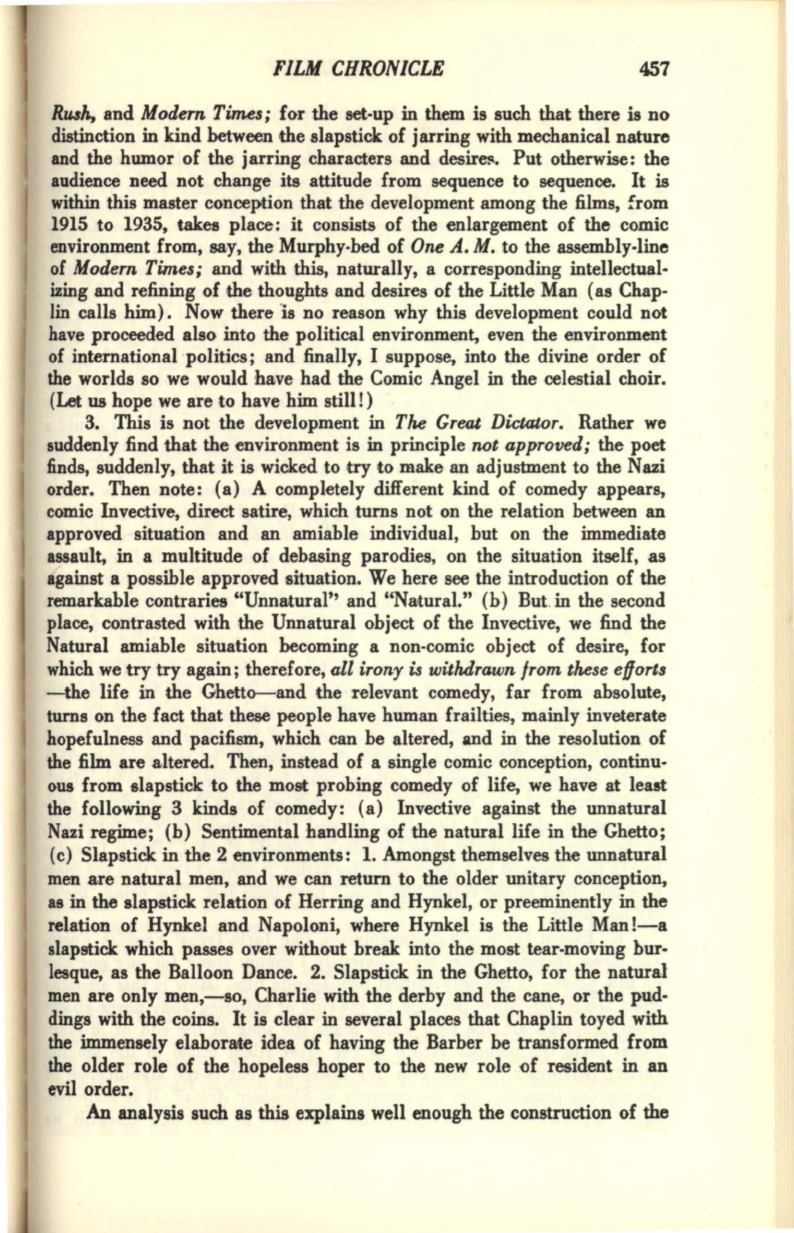
FILM CHRONICLE
457
Rruh,
and
Modern
T~s;
for the set-up in them is such that there is no
distinction in kind between the slapstick of jarring with mechanical nature
and the humor of the jarring characters and desire!!. Put otherwise: the
audience need not change its attitude from sequence to sequence. It
is
within this master conception that the development among the films, from
1915 to 1935, takes place: it consists of the enlargement of the comic
environment from, say, the Murphy-bed of
One A.M.
to the assembly-line
of
Modern Times;
and with
this,
naturally, a corresponding intellectual·
izing and refining of the thoughts and desires of the Little Man (as Chap·
lin calls him). Now there 'is no reason why this development could not
have proceeded also into the political environment, even the environment
of international politics; and finally, I suppose, into the divine order of
the worlds so we would have had the Comic Angel in the celestial choir.
(Let
us hope we are to have him still!)
3. This is not the development in
The Great Dictator.
Rather we
suddenly find that the environment is in principle
not approved;
the poet
finds, suddenly, that it is wicked to
try
to make an adjustment to the Nazi
order. Then note: (a) A completely different kind of comedy appears,
comic Invective, direct satire, which turns not on the relation between an
approved situation and an amiable individual, hut on the immediate
assault, in a multitude of debasing parodies, on the situation itself, as
against a possible approved situation. We here see the introduction of the
remarkable contraries "Unnatural'' and "Natural." (h) But. in the second
place, contrasted with the Unnatural object of the Invective, we find the
Natural amiable situation becoming a non-comic object of desire, for
which we
try
try again; therefore,
all irony
is
witlulrawn from these efforts
-the life in the Ghetto-and the relevant comedy, far from absolute,
turns on the fact that these people have human frailties, mainly inveterate
hopefulness and pacifism, which can he altered, and in the resolution of
the film are altered. Then, instead of a single comic conception, continu–
ous from slapstick to the most probing comedy of life, we have at least
the following 3 kinds of comedy: (a) Invective against the unnatural
Nazi regime; (b) Sentimental handling of the natural life in the Ghetto;
(c) Slapstick in the 2 environments:
1.
Amongst themselves the unnatural
men are natural men, and we can return to the older unitary conception,
as in the slapstick relation of Herring and Hynkel, or preeminently in the
relation of Hynkel and Napoloni, where Hynkel is the Little Man!-a
slapstick which passes over without break into the most tear-moving bur·
lesque, as the Balloon Dance. 2. Slapstick
in
the Ghetto, for the natural
men are only men,-so, Charlie with the derby and the cane, or the pud–
dings with the coins. It is clear in several places that Chaplin toyed with
the immensely elaborate idea of having the Barber be transformed from
the older role of the hopeless hoper to the new role ilf resident
in
an
evil order.
An
analysis such as this explains well enough the construction of the


